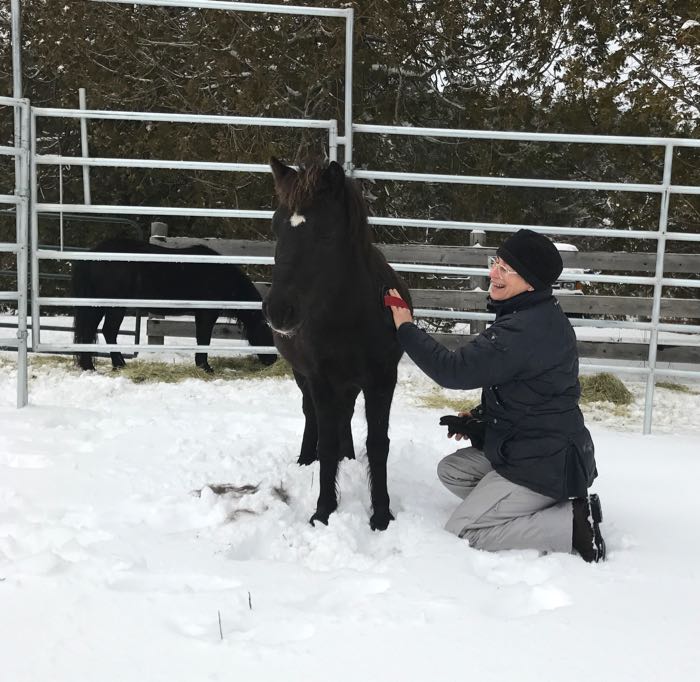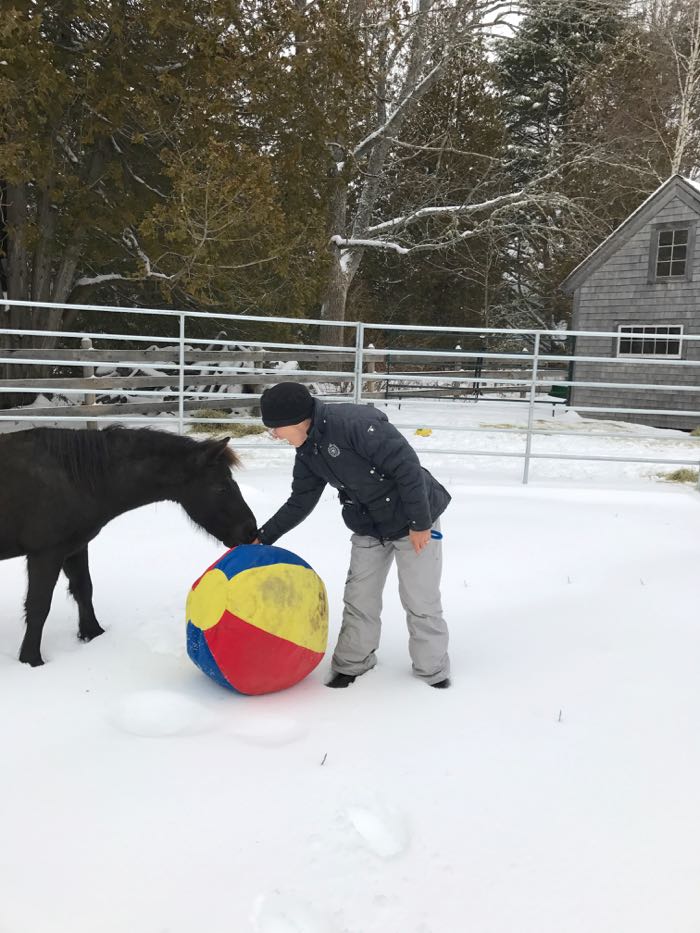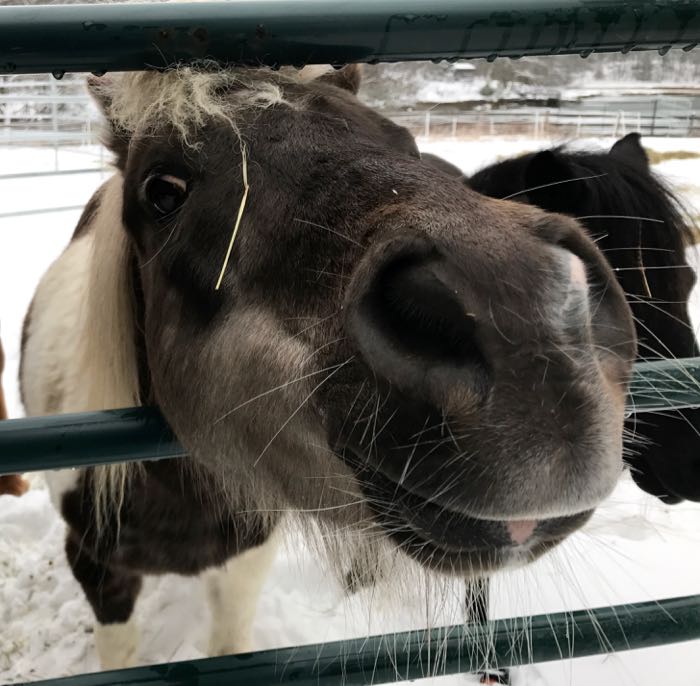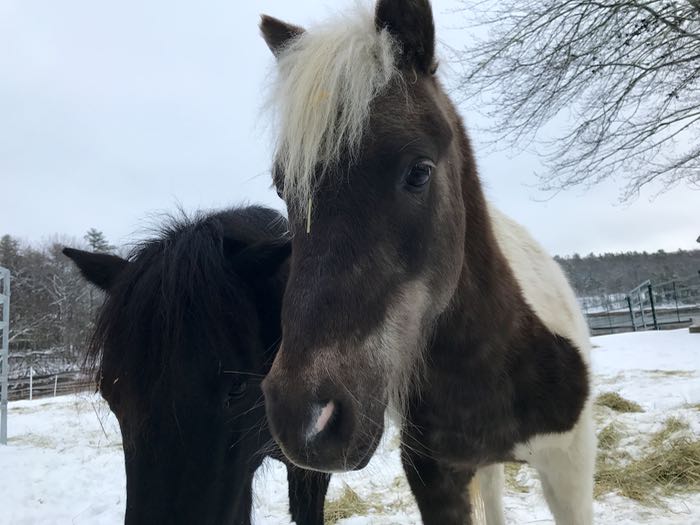I recently started working with four horses. Three are minis. They were rescued from a hoarding situation. The other is a BLM Mustang, which means she was collected on the open range, shunted from holding pen to holding pen, shipped across the country, put in yet another pen, then finally adopted by her current owner. Along the way these horses experienced sudden losses of family groups, food deprivation and harsh handling. Some horses get lucky. These four certainly did. They will live out the rest of their lives on an idyllic farm in coastal Maine.
They’ve had the last year to settle in and begin to believe that the gentle handling and abundant food that they are now getting is the norm. The minis could remain pasture pets, however one of them has a steady and curious temperament and seems to want more. The owner would like to teach him to drive. The mustang filly is now three years of age and it’s time for her to begin her training to become her owner’s trail riding partner.
I work with animals using the principles of operant learning, which means that behavior is controlled by consequences. I carefully observe the animals, give them room and opportunity to do what I want, and reinforce when I see even the smallest of steps to the desired end. Although what I do is steeped in science, there are many judgement calls to make, and those are based on experience and feel (a term that irks scientists, but you know it when you see it!) Food is usually the most effective reinforcer and the easiest to use, but sometimes not. Sometimes I use a distinct marker, like a clicker, before dispensing the food, but sometimes I don’t. These horses provide me with the perfect cases to explain when I use a clicker and when I don’t.
Rory somehow survived his previous life with no emotional baggage. He’s a little fellow, so I did this evaluation at his level in the snow! It’s shedding season so he really enjoyed the currying. Even at liberty he stayed with me and wanted more.

I checked how he responded to being hand-fed. I gave Rory a little hay pellet and he took it politely and calmly, with ears forward and a cheerful expression.

This is a horse that I can get right into clicker training with. I don’t teach tricks for the cuteness factor (although there is that.) I teach tricks as a way to introduce the horse to the idea that I have an activity that we can do together, and that the more he pays attention and gets involved, the more fun it is for him. A good introductory trick is to teach a horse to roll a ball. I put one in front of Rory. He looked at it and I clicked – after all, he can’t roll the ball unless he focuses on it. This was the first step.

He approached it and touched it with his nose. Click! and treat.

Six clicks later, Rory was pushing the ball with his nose. He learned that what he does matters to me. He learned that I will clearly communicate with him. He learned that engaging with me is fun. Trick training opens this communication. When springtime comes, we’ll be able to transfer this attitude to introducing him to a harness and cart.
Mick was also curious. When I first arrived he came to say hello. Through the gate.

But when I came into his space without a barrier, he reverted to his shy and wary self. He needed his sidekick, Caroline, to feel safe. So I sat on the ground and let him blow on me. I offered him treats. He wanted them, but was anxious that he had to be near me to get them. Horses that have been food deprived can get anxious when food is present. In their past, food triggered conflict with other horses, and often tense resource guarding situations. Sometimes a horse is so needy about getting food that they’ll do things that make them uneasy, like, in this case, Mick coming near me. So I put the hay pellets in my pocket. I sat quietly in the snow and breathed slowly. This made Mick curious. When I saw a drop in his tension, I held out my hand and gave him a bit of pellets. In this way I let Mick know that coming close to me didn’t matter, but that being relaxed does. Soon I was worried that Mick was going to try and sit in my lap. I got up.
I could have used a clicker to do this work with Mick, but I didn’t want him to think that it was game on. Sometimes the engagement you want is simply to calmly be. For that I prefer this soft and undemanding approach.

I left the owner with homework. By the time I return this spring, I’m sure that Rory will be pushing that ball into a goalpost, and that Mick will be engaging with humans with confidence. All Caroline has to do is to be the steady sidekick. That’s what she told me was her job. We’re all fine with that. It’s all about the individual and the conversation that you have with them. I’m sure that each of these horses will have something new to tell me when I see them again.


love your posts, thank you
Thank you for the wonder read. What a joy!
wonderful read. sorry I was too quick with the send….
Love the minis, wonderful blog…:)
Will be interesting to see how the mustang progresses next time you see them. Anyway, it gave you something interesting to do in all that snow.
Despite riding full sized horses, I too found myself utterly charmed by a tiny pony many years ago. Careful, Terry! They sneak right up on their tiny teacup hooves and steal your heart with their oversized personalities and an interaction style only the truly small and defenseless employ. I can’t wait to follow the progress of this bunch.